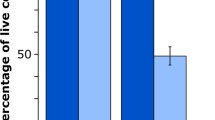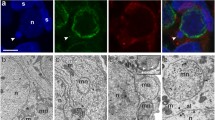Abstract
The behavior of various plasmid templates was examined following their microinjection into fertilized eggs of the frog Xenopus laevis using an assay that permits the examination of both replicated and unreplicated plasmids in single eggs. Our results show that both the size and the topology of the template drastically affect the fate of the injected plasmid. Only a small proportion of injected monomeric supercoiled plasmids underwent replication during 6 h of incubation, although not all injected cells supported replication. Nicked circles were less stable than supercoiled molecules, and we could not detect their replication. Linear monomeric molecules polymerized into large, randomly oriented multimers which were extensively, but not entirely, replicated. Similar results were obtained when linear templates were ligated into polymeric forms in vitro prior to injection. Thus large molecules or molecules which, due to their topology, could be converted into high molecular weight forms following injection were preferred templates for replication. On rare occasions tandemly repeated, high molecular weight DNA was generated following the injection of supercoiled plasmid monomers. This large DNA was shown to be almost entirely replicated.
Similar content being viewed by others
References
Andres AC, Muellener DB, Ryffel GV (1984) Persistence, methylation and expression of vitellogenin gene derivatives after injection into fertilized eggs of Xenopus laevis. Nucleic Acids Res 12:2283–2302
Bendig MM (1981) Persistence and expression of histone genes injected into Xenopus eggs in early development. Nature 292:65–67
Bendig MM, Williams JG (1983) Replication and expression of Xenopus laevis globin genes injected into fertilized Xenopus eggs. Proc Natl Acad Sci USA 80:6197–6201
Bendig MM, Williams JG (1984) Fidelity of transcription of Xenopus laevis globin genes injected into Xenopus oocytes and unfertilized eggs. Mol Cell Biol 4:2109–2119
Blow JJ, Laskey RA (1986) Initiation of DNA replication in nuclei and purified DNA by a cell-free extract of Xenopus eggs. Cell 47:577–587
Brinster RL, Chen HY, Trumbauer M, Senear AW, Warren R, Palmiter RD (1981) Somatic expression of herpes thymidine kinase in mice following injection of a fusion gene into eggs. Cell 27:223–231
Brown DD, Dawid IB (1968) Specific gene amplification in oocytes. Science 160:272–280
Capecchi MR (1980) High efficiency transformation by direct microinjection of DNA into cultured mammalian cells. Cell 22:479–488
Carroll D, Wright SH, Wolff RK, Grzesiuk E, Maryon EB (1986) Efficient homologous recombination of linear DNA substrates after injection into Xenopus laevis oocytes. Mol Cell Biol 6:2053–2061
Chambers JC, Watanabe S, Taylor JH (1982) Dissection of a replication origin of xenopus DNA. Proc Natl Acad Sci USA 79:5572–5576
Endean D (1986) The fate of plasmid DNA following microinjection into fertilized eggs of the frog xenopus laevis. Thesis, University of Wisconsin-Madison, Wis
Etkin LD, Pearman B, Roberts M, Bektesh SL (1984) Replication, integration and expression of exogenous DNA injected into fertilized eggs of xenopus laevis. Differentiation 26:194–202
Folger, KR, Wong EA, Wahl G, Capecchi MR (1982) Patterns of integration of DNA microinjected into cultured mammalian cells: evidence for homologous recombination between injected plasmid DNA molecules. Mol Cell Biol 2:1372–1387
Forbes DJ, Kirschner MW, Newport JW (1983) Spontaneous formation of nucleus-like structures around bacteriophage DNA microinjected into Xenopus eggs. Cell 34:13–23
Ford CC, Woodland HR (1975) DNA synthesis in oocytes and eggs of Xenopus laevis injected with DNA. Dev Biol 43:189–199
Gargiulo G, Wasserman W, Worcel A (1983) Properties of the chromatin assembled on DNA injected into Xenopus oocytes and eggs. Cold Spring Harbor Symp Quant Biol 47:549–566
Gilbert W, Dressler D (1968) DNA replication: the rolling circle model. Cold Spring Harbor Symp Quant Biol 33:473–484
Gurdon JB, Birnstiel ML, Speight VA (1969) The replication of purified DNA introduced into living egg cytoplasm. Biochim Biophys Acta 174:614–628
Harland RM, Laskey RA (1980) Regulated replication of DNA microinjected into eggs of Xenopus laevis. Cell 21:761–771
Hines PJ, Benbow RM (1982) Initiation of replication at specific origins in DNA molecules microinjected into unfertilized eggs of the frog Xenopus laevis. Cell 30:459–468
Hiraga S, Sudo T, Yoshida M, Kubota H, Veyama H (1982) In vitro replication of recombinant plasmids carrying chromosomal segments of Xenopus laevis. Proc Natl Acad Sci USA 79:3697–3701
Hirt JB (1967) Selective extraction of polyoma DNA from infected mouse cell cultures. J Mol Biol 26:365–369
Hogan B, Costantini F, Lacy E (1986) Manipulating the mouse embryo. Cold Spring Harbor Laboratory, New York, p 154
Hourcade D, Dressler D, Wolfson J (1973) The amplification of ribosomal RNA genes involves a rolling circle intermediate. Proc Natl Acad Sci USA 70:2926–2930
Laskey RA, Gurdon JB (1973) Induction of polyoma DNA synthesis by injection into frog-egg cytoplasm. Eur J Biochem 37:467–471
Laskey RA, Honda BM, Mills AD, Morris NR, Wyllie AH, Mertz JE, deRobertis EM, Gurdon JB (1978) Chromatin assembly and transcription in eggs and oocytes of Xenopus laevis. Cold Spring Harbor Symp Quant Biol 42:171–178
Mandel M, Higa A (1970) Calcium dependent bacteriophage DNA infection. J Mol Biol 53:159–162
Maniatis T, Fritsch EF, Sambrook J (1982) Molecular cloning. Cold Spring Harbor Laboratory, New York, p 90
Marini NJ, Etkin LD, Benbow RM (1988) Persistence and replication of plasmid DNA microinjected into early embryos of Xenopus laevis. Dev Biol 127:421–434
McKnight GS, Hamner RE, Kuenzel EA, Brinster RL (1983) Expression of the chicken transferrin gene in transgenic mice. Cell 34:335–341
McMahon AP, Flytzanis CN, Hough-Evans BR, Katula KS, Britten RJ, Davidson EH (1985) Introduction of cloned DNA into sea urchin egg cytoplasm: replication and persistence during embryogenesis. Dev Biol 108:420–430
McTiernan CF, Stambrook PJ (1980) Replication of DNA templates injected into frog eggs. J Cell Biol 87:45 a
McTiernan CF, Stambrook PJ (1984) Initiation of SV40 DNA replication after microinjection into Xenopus eggs. Biochim Biophys Acta 782:295–303
Mechali M, Kearsey S (1984) Lack of specific sequence requirement for DNA replication in Xenopus eggs compared with high sequence specificity in yeast. Cell 38:55–64
Mertz JE, Miller TJ (1983) In vivo catenation and decatenation of DNA. Mol Cell Biol 3:126–131
Murray AW, Schultes NP, Szostak JW (1986) Chromosome length controls mitotic chromosome segregation in yeast. Cell 45:529–536
Newport J (1987) Nuclear reconstitution in vitro: stages of assembly around protein-free DNA. Cell 48:205–217
Newport J, Kirschner M (1982a) A major developmental transition in early Xenopus embryos. I. Characterization and timing of cellular changes at the midblastula stage. Cell 30:675–686
Newport J, Kirschner M (1982b) A major developmental transition in early Xenopus embryos. II. Control of the onset of transcription. Cell 30:687–696
Palmiter RD, Chen HY, Brinster RL (1982) Differential regulation of metallothionein-thymidine kinase fusion genes in transgenic mice and their offspring. Cell 29:701–710
Rigby PWJ, Dieckmann M, Rhodes C, Berg P (1977) Labeling deoxyribonucleic acid to high specific activity in vitro by nicktranslation with DNA polymerase I. J Mol Biol 113:237–251
Rusconi S, Schaffner W (1981) Transformation of frog embryos with a rabbit β-globin gene. Proc Natl Acad Sci USA 78:5051–5055
Southern EM (1975) Detection of specific sequences among DNA fragments separated by gel electrophoresis. J Mol Biol 93:503–517
Stephens DL, Miller TJ, Silver L, Zipser D, Mertz JE (1981) Easyto-use equipment for the accurate microinjection of nanoliter volumes into the nuclei of amphibian oocytes. Anal Biochem 114:299–309
Stinchcomb DT, Shaw JE, Carr SH, Hirsh D (1985) Extrachromosomal DNA transformation of Caenorhabditis elegans. Mol Cell Biol 5:3484–3496
Tocchini-Valentini GP, Baldi MI, Carrara G, Attardi DG, Mattoccia E (1978) Two cell-free systems constructed from xenopus oocytes: generalized genetic recombination; DNA supercoiling. Cold Spring Harbor Symp Quant Biol 43:603–611
Vanin EF, Henthorn PS, Kioussis D, Grosveld F, Smithies O (1983) Unexpected relationships between four large deletions in the human β-globin gene cluster. Cell 35:701–709
Wahl GM, Stern M, Stark GR (1979) Efficient transfer of large DNA fragments from agarose gels to diazobenzyloxymethylpaper and rapid hybridization by using dextran sulfate. Proc Natl Acad Sci USA 76:3683–3687
Watanabe S, Taylor JH (1980) Cloning an origin of DNA replication of Xenopus laevis. Proc Natl Acad Sci USA 77:5292–5296
Zakian VA, Blanton HM, Wetzel L, Dani GM (1986) Size threshold for Saccharomyces cerevisiae chromosomes: generation of telocentric chromosomes from an unstable minichromosome. Mol Cell Biol 6:925–932
Author information
Authors and Affiliations
Rights and permissions
About this article
Cite this article
Endean, D.J., Smithies, O. Replication of plasmid DNA in fertilized Xenopus eggs is sensitive to both the topology and size of the injected template. Chromosoma 97, 307–314 (1989). https://doi.org/10.1007/BF00371971
Received:
Revised:
Issue Date:
DOI: https://doi.org/10.1007/BF00371971




